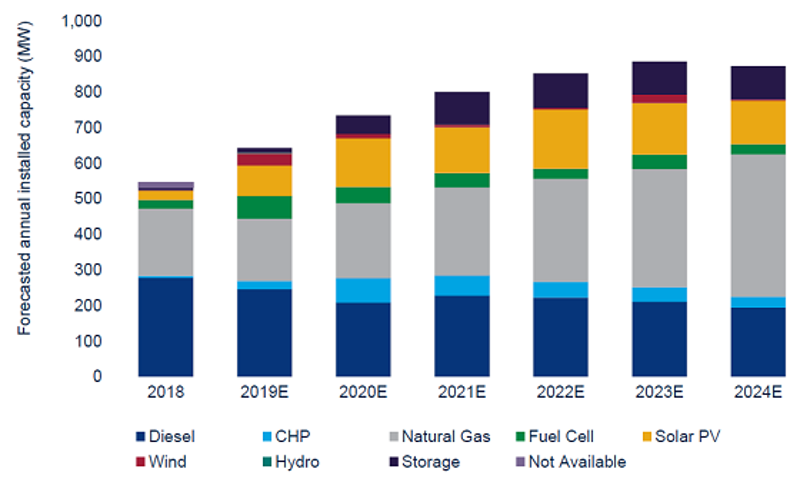
The U.S. is adopting microgrids at record levels
Fossil generation continued to dominate the growing US microgrid market in 2018.
The microgrid market is larger than ever, with 545 megawatts of new capacity added in the United States last year.
Microgrids with standalone fossil-fuel-based generation dominated the microgrid market in 2018. Over the next five years, fossil fuels will continue to remain the primary generation source in both basic systems, which have one distributed energy resource (DER), and advanced multi-DER microgrids, even as solar and storage capacity grows.
Our new report on microgrids summarizes key market trends based on the 2,250 microgrids WoodMac is tracking across the country. (Wood Mackenzie requires a microgrid to have at least 24 hours’ worth of backup generation in order to qualify as a microgrid, according to lead author of the report Isaac Maze-Rothstein.)
Due to high total system costs for 24 hours of storage paired with solar, solar-plus-storage won’t overtake fossil-based microgrids within the forecast timeline.
Although there is more solar capacity in the project pipeline than has been installed in all operational microgrid systems to date, the role of solar through 2024 will primarily be as a secondary capacity source, typically supporting a fossil fuel generator. Many new solar and fuel-cell-paired microgrid systems will start construction in 2019 and 2020 to take advantage of the federal Investment Tax Credit.
New financing options for basic microgrids helped get more of these microgrid systems in place in 2018. Third-party financing supported 80 percent of new basic microgrids in 2018 and will be a critical factor enabling sustained microgrid market growth.
More than half of all 2018 U.S. microgrid projects were third-party-owned, a financing shift that is allowing microgrids to compete more easily with backup gensets.
Financing options for microgrid development are making microgrids a more accessible solution for price-sensitive organizations. These organizations can now tap new opportunities for demand-charge management, and are not required to allocate capital away from their core business.
The Southeastern United States led the country in microgrid deployment last year according to the report, a shift that occurred in the absence of state incentives. It appears that the desire for resilient energy infrastructure has been driving organizations and businesses to invest in microgrids. Florida saw the greatest increase in deployment year-over-year, likely linked to recent hurricanes in the state.
Forecasted installed US microgrid capacity by technology type

Source: Wood Mackenzie Power & Renewables
Although there is more solar capacity in the project pipeline than has been installed in all operational microgrid systems to date, the role of solar through 2024 will primarily be as a secondary capacity source, typically supporting a fossil fuel generator. Many new solar and fuel-cell-paired microgrid systems will start construction in 2019 and 2020 to take advantage of the federal Investment Tax Credit.
New financing options for basic microgrids helped get more of these microgrid systems in place in 2018. Third-party financing supported 80 percent of new basic microgrids in 2018 and will be a critical factor enabling sustained microgrid market growth.
More than half of all 2018 U.S. microgrid projects were third-party-owned, a financing shift that is allowing microgrids to compete more easily with backup gensets.
Financing options for microgrid development are making microgrids a more accessible solution for price-sensitive organizations. These organizations can now tap new opportunities for demand-charge management, and are not required to allocate capital away from their core business.
The Southeastern United States led the country in microgrid deployment last year according to the report, a shift that occurred in the absence of state incentives. It appears that the desire for resilient energy infrastructure has been driving organizations and businesses to invest in microgrids. Florida saw the greatest increase in deployment year-over-year, likely linked to recent hurricanes in the state.












